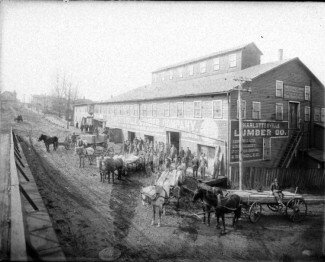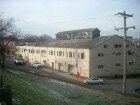Docu-demo: Lumber building gone, but not forgotten
 The Charlottesville Lumber building in its heyday, circa 1917.
The Charlottesville Lumber building in its heyday, circa 1917.PHOTO BY RUFUS HOLSINGER. FROM UVA SPECIAL COLLECTIONS LIBRARY.
In December, the old Charlottesville Lumber building on Avon Street was lost, demolished in dramatic fashion by Parham Construction. But thanks to members of Preservation Piedmont, it was not forgotten.
Alarmed by such architectural losses, the non-profit launched a program in 2004 called "Document Before Demolish," which seeks to record endangered buildings with photos, field notes, and drawings before they come down. However, because the city has yet to officially adopt the program, Preservation Piedmont members have taken it upon themselves to do the documenting.
Unfortunately for preservationists, the 116-year old lumber building, home to businesses as recently as last spring, fell just yards outside the boundary of the Downtown Architectural Design Control district, which protects the circa-1885 Beck-Cohen building next door. In 2008, the old lumber building also slipped through the cracks of a city-wide effort to protect century-old buildings. According to city preservation planner Mary Joy Scala, the building wasn’t recommended by any of the experts called on during the 2008 survey.
However, according to Preservation Piedmont president Eryn Brennan, the building was surely significant enough to document. While the current owners of the building (the Nunley family, who own Better Living) wouldn’t allow Brennan and her team to go inside, they couldn't stop the researchers from casing the joint from the street–- taking measurements, making drawings, taking photographs, and peering in the windows to try to get an accurate record just a week before the structure went down.
“It’s an unfortunate loss,” says Brennan, “but at least there’s a record of it, of Charlottesville’s modest industrial history.”
Brennan says that numerous additions wrapped around the original timber frame construction of the building, and that the ââ?¬Ë?monitor roof’ on its peak was unique for the period. As Brennan explains, such additions were a way of bringing more light and space to roof-top spaces at a time when wooden roof beams (no metal roof trusses back then) could only span short distances before becoming unsafe.
“If people could have seen a building like this restored,” says Brennan, “it would have been great.”
Skip Willis, a neon artist who keeps his studio in the Beck-Cohen building, of which he is co-owner, wonders why the building next door was so hastily demolished, considering the owners have no immediate plans to develop the property. Nunley family representative Caroline Nunley Satira has said the building was brought down because it was unsafe, but Willis points out that the Better Living mill shop was operating there just a few months before the building was demolished. As Willis opined, the family probably wanted to “get it down as quickly as possible” before anyone tried to enact legal measures to block the demolition.
Regardless, because the building was not protected, the Nunleys had every right to take it down.
Still, as Brennan points out, while moments like this might make a preservationist weep, they are also calls to action.
“Hopefully, it’s this kind of event that becomes a tool for casting our eyes wider to see what’s in danger out there,” she says. “So we can preempt this kind of thing in the future.”


17 comments
I am sure they demolished the building for exactly the reasons stated. It is their building and they have the right to tear it down without interference from others. Old is not "historic"
There is a national building museum in DC go visit it. There will be virtual tours of all kinds of old buildings on the net that you will be able to see on your 70 inch screens.
The government should be vary careful about sticking its nose into private peoples properties unless they are willing to pay handsomely for the privilege.
Washington DC has all kinds of rules but when they needed a new stadium for a private basball team they ignored all the rules and demolished old buildings like nothing. Then they refused to pay market value. The government wants it both ways.
If the building were truly unique or somebody had shot Lincoln there I could see the point but that beast of a wharehouse was nothing more than a decrepid eyesore that was most likley a firetrap.
*warehouse*
who cares any more .. historic, historical, old .. nobody really gives a $h*t anymore about ties to the past .. sad but true! The importance of history seems to have fallen through the cracks somewhere along the line.
Rob,
I respect that you wanted to save the building. But unless you were willing and able to set up a collection to insure the building, pay the taxes on it, and assume liability when someone got hurt inside it, it was coming down. It's the sad truth that someone could trespass, hurt himself, and take the owners of the building for huge amounts of money due to their own stupidity.
my statement was a continuation of my initail post. The building is old not historic. It was never a place of great debate, an unsolved murder or a house of ill repute.
The owners wanted to tear it down. Their reasons are theirs alone and not mine to ask. My speculation , as is obviously others posting, is that since remodleing it was off the table it was better to tear it down before it burned and KILLED SOMEBODY or became a victim of people who think they have a right (and duty?) to stop people from doing with their own property what they wish because someone else thinks they should.
Ask the Fire chief if he is glad that an abandoned building of that size that close to other buildings is now off his watch. Then call my excuse lame.
Other than to have a place for someone stick their nose where it does not belong what reason could there be to not tear it down and get it over with?
One thing that often jumps out at me from comments to the Hook's articles is that statements of great certainty about thing like the historic values of old buildings often go hand in hand with great uncertainty about simple things like spelling and punctuation. Go figure.
wats yer pnert?
What history are you talking about? It was an old building that had no historical significance. Just because you make a living restoring old buildings does not mean you are more noble than someone who tears one down and builds something BETTER. I retsore old cars but the truth of the matter is 4 wheel disc brakes are BETTER than old drum brakes. And not all old cars should be restored.
I am as saddended as you by the fact that people do not apprciate history but they will not learn it from driving past an old relic on their way to the Pavillion. If you want to teach your grandkid then go to google images and show him a thousand photgtaphs of the buildings in their heyday.
Sometimes old is just old. should we keep propping up Pamela Andersons tatas until she is 75?
I rest my case with a repeat of my initial post:
[who cares any more .. historic, historical, old .. nobody really gives a $h*t anymore about ties to the past .. sad but true! The importance of history seems to have fallen through the cracks somewhere along the line.]
My point exactly Jim .. the ONLY thing that is considered to of historical significance around here HAS to have good ol' T.J.'s name associated with it somehow. Otherwise, I stand by my statement and my "unnecessary drama" .. By the way .. Were you intimately familiar with that building, or are you just blowing wind saying it "was good to no one for nothing." That is the same ignorant mindset that is the root of this senseless demolition. I have been engaged in restoration work for 37 years, and I was intimately familiar with that building, and if someone actually gave a damn, that building could have been restored/renovated. Whether you want to admit it or not, that building held its place in the history of Charlottesville.
So should we expect every old building in town to be town down for the dubious reason that if it were to catch on fire that it might also set fire to its neighbors? That's a lot of demolition.
"Rob, how long would it have taken for the building to burn and take neighboring buildings with it compared to a more modern structure?
That by itself was enough reason to be done with it."
That has got to be the most ridiculous and lame "justification" I have ever laid eyes on! Did you actually write that in all earnest "pound foolish?"
Rob, how long would it have taken for the building to burn and take neighboring buildings with it compared to a more modern structure?
That by itself was enough reason to be done with it.
Rob,
If the Rotunda comes down and a mall goes up on the lawn I'll say "hear hear" to your post. Otherwise it's unnecessary drama. That building was good to no one for nothing. No condos, no industry, no nothing. Somebody said "old doesn't mean historic," or something to that effect. He's a wise man.
I worked in that deathtrap. Good riddance. It would have cost more to renovate than build new. It was a patchwork of a hundred years of making things work to suit the current needs. There are buildings worth savings but that wasn't one.
Perhaps my wording was a bit too strong with the "no one/nothing" comment. But if the owners weren't interested in selling, it kinda makes it moot, right? It stinks that it comes down because of taxes and liability, but I'd be doing the same thing if I was them. Even if they did want to sell, it's unlikely they'd have found a buyer right now, and it would have to go to a very special (read: rich) person to make it into something special.
I just hope that the next person to build there doesn't use the transit center as a model. Then I'll be convinced that it was a major error.
Joe .. That building was structurally sound..admittedly, it had it's fair share of interior alterations,but there was nothing done to compromise the structural integrity of the structure.